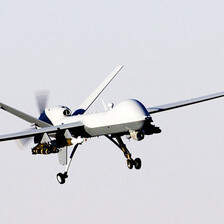The Electronic Intifada 5 April 2010

At best, the Iron Dome system provides temporary security to Israelis while Palestinians develop new tools and techniques to resist their ongoing dispossession. (paffairs_sanfrancisco)
On 25 March the online publication Intelligence Online revealed the development of the vaunted Iron Dome anti-missile system. The system was developed by Haifa-based Rafael Advanced Defense Systems ostensibly to intercept Katyusha, Grad and Qassam rockets coming from the Gaza Strip and Lebanon. The Intelligence Online article however offers a different explanation, stating that “From the outset Iron Dome was always intended for Singapore, which helped finance its development. The island needs a very rapid antimissile system to defend its small territory of less than 700km2. Iron Dome will be battle tested in Israel ahead of export to Singapore at a later date” (“Singapore’s arms tests in Gaza”)
The Iron Dome program has been controversial from its inception in 2005 as other systems have already been developed or are in advanced development, such as Raytheon’s Phalanx or Northrop Grumman’s Skyguard missile intercept systems. These systems are more effective and cheaper than the Iron Dome. These considerations only become important, though, if the primary concern is to obtain and install a functioning rocket and mortar intercept system.
A February 2009 Haaretz article hinted at a foreign buyer being a key reason for the Israel developing its own system — though the earlier Skyguard effort, the Nautilus, was originally a joint US-Israel effort. Military analyst Reuven Pedatzer writes, “Under the deal, said country was to purchase the Iron Dome system and share in financing the project” (“Iron Dome system found to be helpless against Qassams,” 22 February 2008). Another key reason, domestic investment and production, was laid out in the same article by Research and Development directorate officer Shimon Lavie who stated, “ ‘We in the directorate are responsible for developing blue-and-white [Israeli-made] systems.’”
Former Israeli Prime Minister Ehud Olmert in 2008 invoked the need for Iron Dome to protect the southern town of Sderot. “We must establish a multi-layered defensive system. We must complete Iron Dome,” he said (“Israel Cabinet: Gaza Iron Dome System, Reinforcement For Sderot Homes Begins,” Israel News Agency, 24 February 2008). Similar statements have uttered by virtually all Israeli political leaders from Amir Peretz to Tzipi Livni to Benjamin Netanyahu. The system’s extensive costs, significantly more expensive than the US-made alternatives, have led to only one battery being deployed at an Israeli military base. These high costs combined with the nationalist economic motive and primary intent of export, leaving aside the dubious efficacy of the system, all point to a cynical policy decision made by the Israeli government to support its military-industrial complex, even at the expense of its own citizens’ security.
Besides the nationalist economic motive, these efforts at intercepting rockets and mortar shells are products of Israel’s pacification industry. This is in contrast with the surveillance systems, urban warfare theory, drones, checkpoints and other pacification techniques Israel has developed in that these will primarily interact in Israeli towns and cities and with Israeli citizens who can expect to see volleys of anti-missile fire that Palestinians will not. In this it resembles the security checks at bus stations, restaurants, public buildings and other places as examples of the occupation’s enforcement regime that creep over the 1967 boundary into the Israeli citizen’s living space. The comparison can go further in that security checks and Iron Dome are both filtration systems of sorts, one that attempts to catch unwanted objects from the sky and the other to filter unwanted persons from crowds.
Iron Dome is intended to be a checkpoint of sorts, one that attempts to erase or obscure the resistance of the Palestinians warehoused behind the walls of Gaza and the West Bank by intercepting projectiles. If the system is improved, or even replaced with a more effective Tactical High-Energy Laser (THEL) system, it will remain a tool of pacification, nothing more. It thus provides, at best, temporary security while Palestinians develop new tools and techniques to resist their ongoing dispossession. That the Iron Dome, should it ever be actually deployed, is never seen, heard nor physically felt by Palestinians does not change its essential character as another attempt at pacification, not a resolver of conflict. And its export to Singapore is yet another part of the business of exporting the occupation across the globe.
Jimmy Johnson is a supermarket employee in southeast Michigan and can be reached at johnson [dot] jimmy [at] gmail [dot] com.





